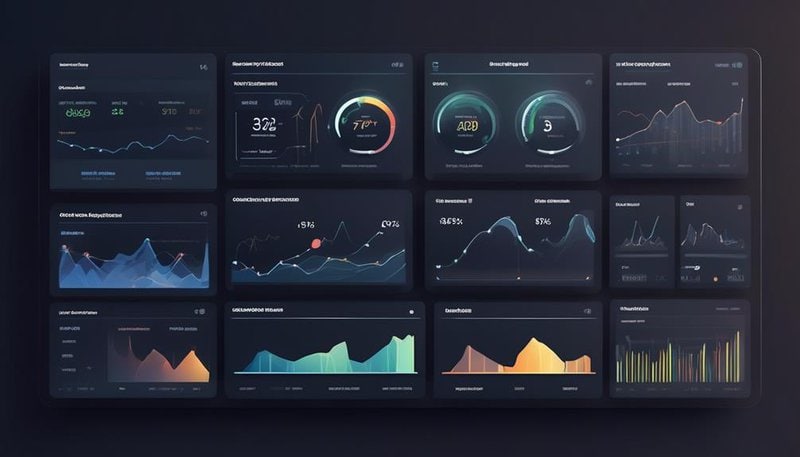Why You Should Monitor Your Shopify Store's Performance

Monitoring your Shopify store's performance is crucial for success in the ever-evolving digital landscape. It provides invaluable insights to make informed decisions and drive growth for your online business.
By monitoring key metrics such as website traffic, conversion rate, average order value, and customer retention, you can identify areas of improvement and optimize your store's performance.
Additionally, monitoring your store's performance allows you to track the success of marketing campaigns, identify trends, and make data-driven decisions to increase sales and customer satisfaction.
There are various tools and analytics platforms available that can help you monitor your Shopify store's performance, such as Google Analytics, Shopify Analytics, and third-party apps.
Regularly reviewing and analyzing these metrics will enable you to identify opportunities for growth, address any issues or bottlenecks, and ultimately improve your store's overall performance and profitability.
Key Metrics to Track
To effectively monitor the performance of your Shopify store, it's crucial to track key metrics that provide data-driven insights into its success.
Two essential metrics to focus on are conversion rate and customer satisfaction.
Firstly, tracking your conversion rate is vital to understanding how effectively your store is turning visitors into customers. This metric measures the percentage of visitors who make a purchase on your site. By monitoring your conversion rate, you can identify areas for improvement in your sales funnel, website design, or product offerings. A higher conversion rate indicates that your store is attracting and engaging the right audience, leading to increased revenue and profitability.
Secondly, customer satisfaction is an integral metric that determines the success of your Shopify store. Keeping your customers happy and satisfied is crucial for building long-term relationships and driving repeat purchases. Monitoring customer satisfaction can be done through surveys, reviews, and feedback. By understanding the factors that contribute to customer satisfaction, such as product quality, shipping time, and customer service, you can make necessary improvements to enhance the overall customer experience.
Identifying Areas for Improvement
To identify areas for improvement in your Shopify store's performance, you need to conduct a thorough analysis of your performance metrics.
By analyzing data-driven metrics such as conversion rates, bounce rates, and average order value, you can pinpoint specific areas that require optimization.
Once you have identified these areas, you can develop targeted strategies to improve your store's performance and drive more sales.
Performance Metrics Analysis
By analyzing performance metrics, you can identify areas for improvement in your Shopify store's performance. Performance metrics analysis involves tracking and analyzing various data points to gain insights into your store's performance. This data-driven approach allows you to make informed decisions and take actions that can enhance the overall performance of your Shopify store.
To conduct a performance metrics analysis, you need to collect and analyze data such as website traffic, conversion rates, average order value, bounce rates, and customer behavior. By examining these metrics, you can identify patterns, trends, and areas of concern. For example, if you notice a high bounce rate on certain pages, it may indicate that there's an issue with the design or content, which needs improvement.
Additionally, performance metrics analysis can help you identify opportunities for growth and optimization. For instance, if you observe a high conversion rate on a particular product page, you can focus on promoting and expanding that product line to drive more sales.
Data-driven Optimization Strategies
By analyzing the performance metrics of your Shopify store, you can uncover valuable insights and identify specific areas within your store that can be optimized for better performance and results.
Data-driven optimization strategies involve conducting a thorough conversion rate analysis and customer behavior analysis to understand how visitors interact with your store and what influences their purchasing decisions.
Conversion rate analysis allows you to track the percentage of visitors who take a desired action, such as making a purchase or signing up for a newsletter. By identifying the pages or steps in the sales funnel with low conversion rates, you can pinpoint areas for improvement and implement targeted optimization strategies.
Customer behavior analysis involves examining how visitors navigate your store, what products they view, and how long they spend on each page. This data can help you identify potential barriers or friction points that may be hindering the customer journey. By optimizing these areas, you can create a more seamless and enjoyable shopping experience, increasing the likelihood of conversions.
Ensuring Smooth Business Operations
To ensure smooth business operations for your Shopify store, it's crucial to focus on efficiency. By optimizing your performance techniques, you can streamline processes and reduce bottlenecks.
Real-time monitoring provides valuable insights into the health of your operations, allowing you to address issues promptly and make data-driven decisions for continuous improvement.
Efficiency of Operations
Improving the efficiency of your Shopify store's operations is crucial for maintaining smooth and successful business operations. By streamlining your operations, you can optimize your processes and maximize your productivity.
Here are five key areas to focus on:
- Inventory Management: Implementing a robust inventory management system can help you avoid stockouts and overselling, ensuring that you always have enough products to fulfill customer orders.
- Order Processing: Automating order processing tasks, such as order confirmation emails and tracking updates, can save you time and improve customer satisfaction.
- Shipping and Fulfillment: Integrating with shipping carriers and using tools like batch printing labels can streamline your shipping and fulfillment process, reducing errors and delays.
- Customer Support: Utilizing help desk software and chatbots can enhance your customer support efficiency by providing quick and accurate responses to customer inquiries.
- Analytics and Reporting: Regularly analyzing sales data, customer behavior, and website performance can help you identify areas for improvement and make data-driven decisions to optimize your store's operations.
Performance Optimization Techniques
Implementing performance optimization techniques is essential for ensuring smooth business operations in your Shopify store. One crucial aspect of performance optimization is conversion rate optimization, which focuses on increasing the percentage of visitors who make a purchase. By analyzing data and making data-driven decisions, you can identify areas of improvement and implement strategies to enhance your conversion rate.
Additionally, page load speed plays a vital role in providing a seamless shopping experience for your customers. Slow page load speeds can lead to frustration and abandonment, negatively impacting your sales and customer satisfaction. To optimize page load speed, consider compressing images, minimizing JavaScript and CSS files, and utilizing caching techniques.
Real-Time Monitoring Benefits
Analyzing data and making data-driven decisions is essential for ensuring smooth business operations in your Shopify store, and real-time monitoring provides valuable benefits in this regard. With real-time analytics and performance tracking, you can stay informed about the current state of your store and make timely adjustments to optimize its performance.
Here are five key benefits of real-time monitoring:
- Immediate issue detection: Real-time monitoring allows you to identify and address any performance issues as soon as they occur, preventing them from affecting your customers' experience.
- Enhanced customer satisfaction: By monitoring your store's performance in real-time, you can ensure that your website is running smoothly and providing a seamless user experience, leading to higher customer satisfaction.
- Improved conversion rates: Real-time monitoring enables you to identify bottlenecks in your sales funnel and make necessary adjustments to improve conversion rates and increase revenue.
- Proactive decision-making: With real-time analytics, you can make data-driven decisions quickly, allowing you to respond to changing market trends and customer demands in a timely manner.
- Efficient resource allocation: Real-time monitoring helps you optimize resource allocation by identifying areas of your store that require more attention and investment, ensuring that you're making the most of your available resources.
Making Data-Driven Decisions
To make informed decisions based on data, monitor and analyze the performance of your Shopify store. By conducting regular data analysis and performance tracking, you can gain valuable insights into your store's performance and make data-driven decisions to optimize its success.
One way to track your store's performance is by monitoring key performance indicators (KPIs). These are measurable values that indicate how well your store is performing in various areas. By tracking KPIs such as conversion rate, average order value, and customer acquisition cost, you can identify areas of improvement and make data-driven decisions to drive growth.
Another important aspect of data analysis is understanding customer behavior. By analyzing data on customer demographics, purchasing patterns, and browsing behavior, you can tailor your marketing strategies and product offerings to better meet the needs and preferences of your target audience.
To help you visualize the importance of data-driven decision-making, here is a table showcasing the potential impact of different decisions based on data analysis:
| Decision | Potential Impact |
|---|---|
| Introducing a new product | Increase in sales and customer engagement |
| Optimizing website speed | Decrease in bounce rate and increase in conversion rate |
| Personalizing marketing | Higher customer retention and increased customer lifetime value |
Optimizing Store Performance
To optimize the performance of your Shopify store, it's essential to focus on key areas that can drive growth and improve customer engagement. By implementing conversion rate optimization strategies and optimizing your website speed, you can significantly enhance the overall performance of your store.
Here are five key areas to consider:
- Streamline your checkout process: Make it easy and seamless for customers to complete their purchases. Simplify the steps involved and minimize any unnecessary fields or distractions.
- Optimize product pages: Ensure that your product pages are visually appealing, informative, and easy to navigate. Use high-quality images, detailed descriptions, and customer reviews to build trust and encourage conversions.
- Improve website speed: A slow-loading website can lead to high bounce rates and lost sales. Optimize your website's speed by compressing images, caching content, and minimizing code.
- Implement responsive design: In today's mobile-driven world, it's crucial to have a responsive website that adapts to different devices and screen sizes. This ensures a seamless browsing experience for your customers, regardless of the device they're using.
- Personalize the shopping experience: Utilize customer data to provide personalized recommendations, tailored promotions, and targeted marketing campaigns. This can greatly enhance customer engagement and increase conversion rates.
Benefits of Performance Monitoring
When it comes to optimizing your Shopify store's performance, monitoring its performance is essential in order to track key metrics and identify areas for improvement. Regular tracking is important because it allows you to stay updated on how your store is performing and make informed decisions based on real-time data.
By monitoring your store's performance, you can identify any issues or bottlenecks that may be affecting the customer experience. Performance monitoring has a direct impact on the customer experience. Slow page load times, frequent crashes, or errors can frustrate customers and lead to a higher bounce rate, lower conversion rates, and ultimately, lost sales.
By regularly tracking your store's performance, you can identify and address any performance issues promptly, ensuring a smooth and seamless shopping experience for your customers.
Furthermore, performance monitoring allows you to measure the effectiveness of any optimization strategies you implement. By tracking key metrics such as page load times, conversion rates, and average order value, you can determine whether your efforts are yielding the desired results. This data-driven approach enables you to make data-backed decisions and continuously improve your store's performance.
Strategies for Effective Monitoring
What are some effective strategies for monitoring the performance of your Shopify store?
Here are five proactive monitoring techniques and strategies for troubleshooting that can help you keep a close eye on your store's performance:
- Set up performance benchmarks: Establish benchmarks for key metrics such as page load times, conversion rates, and bounce rates. Regularly monitor these benchmarks to identify any deviations and take necessary action.
- Utilize real-time monitoring tools: Invest in monitoring tools that provide real-time data on your store's performance. These tools can help you identify any issues or bottlenecks as they occur, allowing you to address them promptly.
- Implement alert systems: Set up alert systems that notify you when there are significant changes or anomalies in your store's performance. This can help you quickly identify and resolve any issues before they impact your customers' experience.
- Regularly analyze data: Analyze your store's performance data on a regular basis to identify trends and patterns. This can help you proactively address any potential issues and optimize your store's performance.
- Monitor user feedback: Pay attention to customer feedback and reviews to gain insights into any performance issues or bottlenecks. Actively address these concerns to enhance the user experience and improve your store's performance.
Frequently Asked Questions
How Often Should I Check My Shopify Store's Performance Metrics?
You should check your Shopify store's performance metrics regularly to optimize its performance. Best practices for monitoring include tracking sales, conversion rates, page load times, and customer engagement. Stay on top of your store's data to make informed decisions and improve your business.
What Are Some Common Areas for Improvement That Shopify Store Owners Should Focus On?
To improve your Shopify store's performance, focus on conversion rate optimization and website speed optimization. These areas can have a significant impact on your business, boosting sales and enhancing the user experience.
How Can I Ensure Smooth Business Operations for My Shopify Store?
To ensure smooth business operations for your Shopify store, monitor inventory management to avoid stockouts and overstocking. Analyze customer satisfaction metrics like reviews and feedback to identify areas for improvement and enhance the overall shopping experience.
What Are Some Effective Strategies for Monitoring and Improving My Shopify Store's Performance?
To improve your Shopify store's performance, you should focus on website optimization and conduct conversion rate analysis. These strategies will help you identify areas for improvement and make data-driven decisions to enhance your store's success.
Are There Any Specific Data-Driven Decisions I Should Be Making Based on My Shopify Store's Performance Metrics?
To make data-driven decisions for performance optimization, analyze Shopify store metrics like conversion rates, bounce rates, and average order value. Identify trends and areas for improvement, then take action to optimize your store and boost sales.








